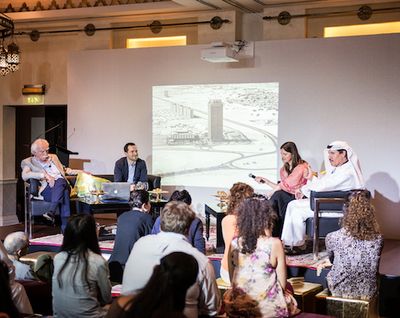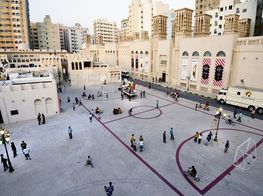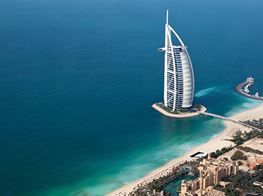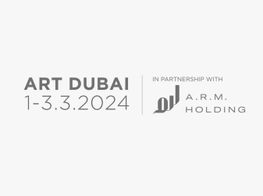Trading Histories For Futures: A Report From Art Dubai And The Sharjah March Meeting

In a scene from Eric Baudelaire’s film The Ugly One dubbed 'The Syrian Dinner', a group of friends argue around a dinner table over Syria from the perspective of Beirut, where the film, based on a story by Masao Adachi, is set. The scene expresses dissonance contained within a “harmonious” communal space (the dinner table), or frame (the film as composition), also reflecting the very context within which The Ugly One was screened: the annual March Meeting organized by the Sharjah Art Foundation, which brings together multiple voices not necessarily united by shared ideas or common histories, but by a discursive space – the meeting itself.
It was fitting, therefore, that this year’s March Meeting was titled Come Together. After all, the UAE is precisely the place where a spectrum of the art world has traditionally and literally come together in March, mainly through Sharjah Art Foundation and Art Dubai (though with Art Basel in Hong Kong’s recent announcement of its new March dates, this might change). The results of such get togethers have been fruitful. At the opening of Art Dubai’s eighth edition this year, which took place just a day after the March Meetings ended, Antonia Carver pointed out how Dubai – and thus by wider extension Sharjah and the UAE – “has become a meeting point not only for the exchange of ideas but the production of ideas.”
It’s true. As a fair, Art Dubai has grown in leaps and bounds in recent years so as to catch up with the level of discussion that takes place at Sharjah’s March Meetings and biennial exhibitions, which continue to evolve under the direction of Hoor Al-Qasimi, recently appointed the curator of the UAE pavilion at the next Venice Biennale. In the case of Art Dubai, this year marked a true balance between the “$”, the “BLAH BLAH BLAH” (quoting works by Moris at Baro Galeria), and the fair’s intellectual rigor, which might explain why it didn't feel all that bad to stare into Mona Hatoum’s mirror presented at Chantal Crousel, in which the words “You’re Still Here” were engraved.
When it comes to the obstacles Art Dubai has crossed in terms of nurturing a new kind of art fair altogether, this year’s Marker (the fair’s curated section), which focused on Central Asia and the Caucasus as curated by Slavs and Tatars, said it all. Having dissolved the obvious boundaries between booths to produce a more integrated design for the five spaces included at Marker, Slavs and Tatars explained how they had to convince the spaces that this dissolution of divides was a good thing. “I mean come on,” noted one Slav quoting another Slavs and Tatars project: “friendship of nations, right?”
Right. It is precisely this approach that has made Sharjah and Dubai meeting places for a new kind of global community; one that JJ Charlesworth’s observed in his review of Art Dubai in 2013, when he asked: “is this what the art world of the future looks like?” Charlesworth posed the question while taking note of the fair’s cultural scope, which reflected Yuko Hasegawa’s theme for the Sharjah Biennial that year, which called for a new cartography via the Global South. This cartography was also reflected in the title of one of the first sessions of Global Art Forum 8 (held at Doha) this year, between Solange Farkas and Ala Younis: Migrations in film and video: From the Arab World to Brazil and Back Again.
Of course, Art Dubai has, like Sharjah, strategically positioned itself – borrowing the words printed on one of Elena Damiani’s black and white collages produced from vintage postcards showing at Selma Feriani Gallery – “as far as east is from west.” From New York’s Marian Goodman Gallery to GAGPROJECTS (Adelaide/ Berlin), to Vienna’s Galerie Krinzinger and Turin’s Galleria Franco Noero, to Lagos’s Omenka Gallery presenting works by Nnenna Okore and Tchif, not to mention the double presentation of Otobong Nkanga’s illustrations alongside Meschac Gaba’s flags-as-travelling-bundles (representing the US, the EU, the Arab League, the African Union and the UK) at Amsterdam’s Lumen Travo, Art Dubai is a cultural smorgasbord. It reflects the historical complexity of the Persian Gulf and the world around it, from Asia to Africa, just as CAMP did in their work produced with the Sharjah Art Foundation, From Gulf to Gulf to Gulf, which was screened as part of the 2014 March Meeting.
Indeed, throughout Art Dubai’s booths, cartographical exercises emerged as a common theme. From Tiffany Chung at Tyler Rollins Fine Art, Ali Cherri at Galerie Imane Farès (whose artist Younes Rahmoun won this year’s John Jones Art on Paper award), to Luis Camnitzer at Alexander Gray Associates, and Bouchra Khalili at Galerie Polaris, artists traced common geographical links that extended into shared historical legacies. At Grey Noise, Murad Khan Mumtaz and Alyssa Pheobus Mumtaz presented Origin, Departure (2010-2011), a series of interventions on magnified digital reproductions of passport pages exploring a shared experience of living and travelling between the US and Pakistan, while Hew Locke presented archive certificates from the colonial era at Hales Gallery, from share certificates such as The Ottoman Company Limited, Junction Tin Mine Nigera and Banque Du Liban, over which Locke intervened with his own illustrated maps.
Amongst these granular mappings, it was fitting that histories rather than “History” became the focus for this year’s Global Art Forum 8 (Art Dubai’s brain), titled Meanwhile…History (coined by Sophia Al Maria). Presided over by Commissioner Shumon Basar and Co-Directors Ala Younis and Omar Berrada, the forum proposed an investigation into historical gaps and links, from the global resonance of Ibn Khaldun’s medieval treatise the Muqaddimah, to the 1970s both in the UAE and the wider the world (from Greece to Iran), passing through 100 years of Documenta along the way. Aptly, the forum took place next to the fair’s newly launched Modern section, inaugurated this year (with 11 galleries plus one special presentation) to uncover relatively unknown (or under-represented) regional art histories while expanding the art historical canon. Notable presentations included Michel Basbous at Agial Art Gallery, Ardeshir Mohasses at Shirin Art Gallery, Huguette Caland at Galerie Janine Rubeiz, Nabil Nahas at Lawrie Shabibi, Anwar Jalal Shemza at Jhaveri Contemporary, Zahoor ul Akhlaq at ArtChowk and a double presentation of works by Hamed Abdalla and Adam Henein at Karim Francis.
As to why such archaeologies are important, one accusation comes to mind. It is a critique often leveled at the UAE and more specifically at Dubai, a city of megaprojects, by western critics – that this is a place with no history. Responding to this during her session at the Global Art Forum on Kuwait, Assistant Professor in History at the American University of Kuwait, Farah Al-Nakib, put forth another perspective. Taking on the notion of the city as symbol and the architectural landscape as a spatial form reflecting the social, cultural and political changes, she agreed with forum participant Todd Reisz that Dubai is often mistaken for a tabula rasa rather than a space in which layers of history overlap. In a comparative moment, Al-Nakib discussed the building boom in Kuwait that followed the discovery of oil and its subsequent exploration from the 1950s onwards, and explained how the eclectic nature of Kuwait’s post-oil skyline – its assemblage of architectural styles – was not a case of imported modernity at all, but rather an expression of a cycle of demolition, erasure and construction that is universal. For Al-Nakib, these cycles happen throughout the world and at different times: after all, there is no singular modernity, but multiple, overlapping modernities.
Art Dubai encourages such overlappings, as does the Sharjah Art Foundation through its March Meeting, biennial exhibition and annual exhibition programme. The results are geographical and temporal respatializations that, in effect, produce new historical cartographies. After all, as Al-Nakib noted, it is only through a critical relationship with the past that a more ideal future might emerge. Could this explain why, at Sharjah, the March Meeting staged two panel discussions titled, “After History” and “Imagining the Future” as well as an exhibition of works by Rasheed Araeen (also showing at Art Dubai Modern with Grosvenor Gallery) titled Before and After Minimalism, and a retrospective of works by late Dagestani artist, Eduard Puterbrot, titled Between My East and West?
The idea of retroactively recuperating forgotten histories across regions so as to look to the future recalls one of the more unstable aspects of recorded time. This was reflected in Kamrooz Aram’s Abraaj Capital Art Prize project titled: Ancient Through Modern: A Collection of Uncertain Objects, Part 1., presented alongside fellow winners Basim Magdy, Bouchra Khalili, Abbas Akhavan, and Anup Mathew Thomas, as curated by Nada Raza. (This will be the final year five artists are awarded, with only one artist receiving the Abraaj Prize from 2015, while a new academic prize is launched in collaboration with the RCA in London, which awards five scholars a two-year post-graduate scholarship). In many ways, it is this uncertainty with time and memory that the 2014 Global Art Forum played with. As Shumon Basar noted, history is often characterized more by amnesia than remembrance.
Thus, at Experimenter, Hajra Waheed played with the idea of history as an imaginary construction in Sea Change - Character 1: In the Rough, An Epic Novel (2013-2014), in which Waheed, who also produced a nightly performance as part of Art Dubai Projects (curated by Fawz Kabra), imagined the life and studies of a scientist-stroke-geologist. The installation reflected on the final discussion at the Global Art Forum between Marina Warner and John Akomfrah, in which Warner made the link between stories and histories. After all, if we are to disrupt the notion of “History with a capital H” (as Global Art Forum speaker Oscar Guardiola-Rivera called it), we might treat the many different (and often disconnected) narratives that shape our collective identities as malleable rather than fixed forms.
Yet, when it comes to reinterpreting the past, there are things to consider. As Al-Nakib pointed out, in Kuwait’s second architectural boom, which began in the mid-noughties, there has been a nostalgia for pre-oil architecture in the city-state that is not unlike Sharjah’s current regeneration project in its heritage area, the Heart of Sharjah, where the extraordinary examples of 1970s Gulf Modernism that form the old Sharjah Islamic Bank Buildings on Bank Street have been earmarked for demolition so as to make way for the rebuilding of older architectural forms. The danger here, as Samia Rab of the American University of Sharjah posed during her presentation Alternative Seascapes: The Construction, Restoration and Regeneration of Cultural Heritage in Sharjah at the Sharjah March Meeting, is that in trying to revive the past, we risk losing real history. The old bank buildings being a case in point.
In this light, could it be that the next challenge when it comes to our histories, as posed by the discussions engendered in the UAE this year, is how to move beyond nostalgia and historical fetishization? Could sticking to rigid historical structures or narratives result in counteractive falls from grace, as was suggested in Haig Aivazian’s remarkable pencil drawings at Lombard Freid Projects depicting solitary figures falling from tall, modernist towers? Is it even time to let certain histories go, without sacrificing their memories, so that we might engage with our histories in a softer, more organic way, as proposed by the title of one of Ariel Hassan’s playful abstractions at GAGPROJECTS, organic occurrences forming within the grey zones of pre-existing regimes No. 5 (2014)?
Perhaps this is why Art Dubai opened with Youmna Chlala’s project – local plants arranged on either side of the entrance titled The Desire Path. Though questioning the past in the present has its problems, such interrogations could be vital for the better futures so many are seeking out













































































































































































